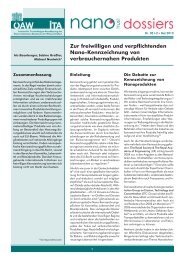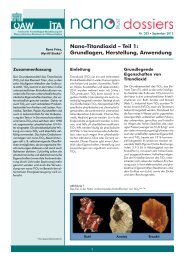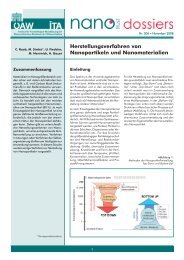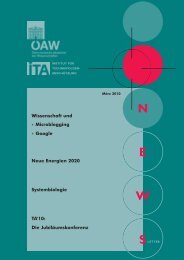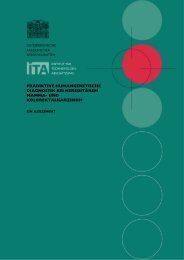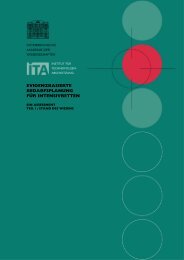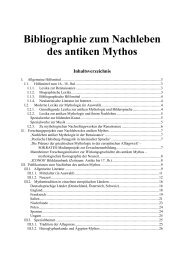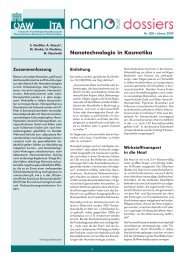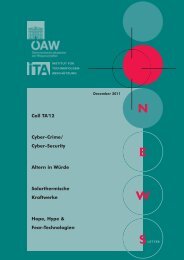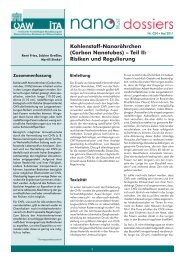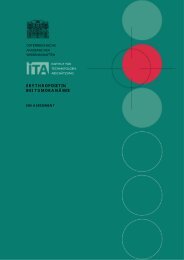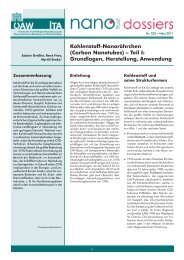Self-cleaning, dirt and water-repellent coatings on the ... - Pub-Portal
Self-cleaning, dirt and water-repellent coatings on the ... - Pub-Portal
Self-cleaning, dirt and water-repellent coatings on the ... - Pub-Portal
You also want an ePaper? Increase the reach of your titles
YUMPU automatically turns print PDFs into web optimized ePapers that Google loves.
Institute of Technology Assessment<br />
of <strong>the</strong> Austrian Academy of Sciences<br />
Sabine Greßler,<br />
Ulrich Fiedeler*, Myrtill Simkó,<br />
André Gazsó, Michael Nentwich<br />
Summary<br />
<str<strong>on</strong>g>Self</str<strong>on</strong>g>-<str<strong>on</strong>g>cleaning</str<strong>on</strong>g>, <str<strong>on</strong>g>water</str<strong>on</strong>g> <str<strong>on</strong>g>and</str<strong>on</strong>g> <str<strong>on</strong>g>dirt</str<strong>on</strong>g>-<str<strong>on</strong>g>repellent</str<strong>on</strong>g><br />
<str<strong>on</strong>g>coatings</str<strong>on</strong>g> have differing properties, functi<strong>on</strong>al<br />
principles <str<strong>on</strong>g>and</str<strong>on</strong>g> manufacturing processes.<br />
<str<strong>on</strong>g>Self</str<strong>on</strong>g>-<str<strong>on</strong>g>cleaning</str<strong>on</strong>g> of <strong>the</strong> “Lotus Effect<br />
® ” type has its basis in chemicalphysical<br />
principles – <strong>the</strong>se surfaces are<br />
characterised by a special roughness<br />
<str<strong>on</strong>g>and</str<strong>on</strong>g> are str<strong>on</strong>gly <str<strong>on</strong>g>water</str<strong>on</strong>g>-<str<strong>on</strong>g>repellent</str<strong>on</strong>g>; in <strong>the</strong><br />
ideal case, rain is sufficient for <str<strong>on</strong>g>cleaning</str<strong>on</strong>g>.<br />
“Easy-to-Clean” materials, in c<strong>on</strong>trast,<br />
have a particularly flat surface, which is<br />
both <str<strong>on</strong>g>water</str<strong>on</strong>g> <str<strong>on</strong>g>and</str<strong>on</strong>g> <str<strong>on</strong>g>dirt</str<strong>on</strong>g>-<str<strong>on</strong>g>repellent</str<strong>on</strong>g> <strong>on</strong> <strong>the</strong> basis<br />
of chemical aspects. Although <strong>the</strong><br />
amount of mechanical <str<strong>on</strong>g>cleaning</str<strong>on</strong>g> may be<br />
reduced, <strong>the</strong>y are not self-<str<strong>on</strong>g>cleaning</str<strong>on</strong>g>. A<br />
third form of self-<str<strong>on</strong>g>cleaning</str<strong>on</strong>g> is that based<br />
<strong>on</strong> photo catalysis by nano titanium dioxide.<br />
On such surfaces UV radiati<strong>on</strong><br />
produces oxygen radicals that decompose<br />
organic material, which in turn is<br />
removed in <strong>the</strong> rain by a <str<strong>on</strong>g>water</str<strong>on</strong>g> film. <str<strong>on</strong>g>Self</str<strong>on</strong>g><str<strong>on</strong>g>cleaning</str<strong>on</strong>g>,<br />
<str<strong>on</strong>g>water</str<strong>on</strong>g> <str<strong>on</strong>g>and</str<strong>on</strong>g> <str<strong>on</strong>g>dirt</str<strong>on</strong>g>-<str<strong>on</strong>g>repellent</str<strong>on</strong>g> <str<strong>on</strong>g>coatings</str<strong>on</strong>g><br />
may reduce <strong>the</strong> amount of <str<strong>on</strong>g>cleaning</str<strong>on</strong>g><br />
necessary <str<strong>on</strong>g>and</str<strong>on</strong>g> hence c<strong>on</strong>tribute to<br />
reducing <strong>the</strong> burden <strong>on</strong> <strong>the</strong> envir<strong>on</strong>ment.<br />
However, eco-balances <str<strong>on</strong>g>and</str<strong>on</strong>g> life cycle assessments<br />
are still lacking. Risks for <strong>the</strong><br />
envir<strong>on</strong>ment <str<strong>on</strong>g>and</str<strong>on</strong>g> human health by nanoscale<br />
<str<strong>on</strong>g>coatings</str<strong>on</strong>g> or nanoparticles firmly<br />
embedded in a coating matrix are currently<br />
deemed ra<strong>the</strong>r unlikely. Initial investigati<strong>on</strong>s<br />
however indicate that titanium<br />
dioxide nanoparticles from house<br />
paint may erode <str<strong>on</strong>g>and</str<strong>on</strong>g> end up in <strong>the</strong> envir<strong>on</strong>ment.<br />
This aspect needs to be analysed<br />
in <strong>the</strong> framework of an all-encompassing<br />
risk assessment.<br />
* Corresp<strong>on</strong>ding author<br />
<str<strong>on</strong>g>Self</str<strong>on</strong>g>-<str<strong>on</strong>g>cleaning</str<strong>on</strong>g>, <str<strong>on</strong>g>dirt</str<strong>on</strong>g> <str<strong>on</strong>g>and</str<strong>on</strong>g><br />
<str<strong>on</strong>g>water</str<strong>on</strong>g>-<str<strong>on</strong>g>repellent</str<strong>on</strong>g> <str<strong>on</strong>g>coatings</str<strong>on</strong>g><br />
<strong>on</strong> <strong>the</strong> basis of nanotechnology<br />
Introducti<strong>on</strong><br />
A surface is not simply <strong>the</strong> physical divisi<strong>on</strong><br />
between an object <str<strong>on</strong>g>and</str<strong>on</strong>g> its envir<strong>on</strong>ment; it<br />
fulfils a range of functi<strong>on</strong>s of its own which<br />
often play a crucial part in product design.<br />
Surfaces are supposed to feel good to <strong>the</strong><br />
touch <str<strong>on</strong>g>and</str<strong>on</strong>g> to look good for as l<strong>on</strong>g as possible,<br />
be easy to maintain <str<strong>on</strong>g>and</str<strong>on</strong>g> not be spoiled<br />
by <str<strong>on</strong>g>dirt</str<strong>on</strong>g>, <str<strong>on</strong>g>water</str<strong>on</strong>g> stains or fingermarks. Traditi<strong>on</strong>al<br />
coating materials often do not st<str<strong>on</strong>g>and</str<strong>on</strong>g><br />
<strong>the</strong> test of <strong>the</strong> increased dem<str<strong>on</strong>g>and</str<strong>on</strong>g>s made<br />
<strong>on</strong> materials today. In recent years however,<br />
advances have been made using methods<br />
ascribed to nanotechnology 1 . The<br />
following gives a short overview of <strong>the</strong> basis<br />
of <strong>the</strong>se structures, <strong>the</strong> processes involved<br />
in <strong>the</strong>ir manufacture, <strong>the</strong> areas<br />
where <strong>the</strong>y can be used, <str<strong>on</strong>g>and</str<strong>on</strong>g> <strong>the</strong> effect <strong>the</strong>y<br />
have <strong>on</strong> <strong>the</strong> envir<strong>on</strong>ment <str<strong>on</strong>g>and</str<strong>on</strong>g> human<br />
health.<br />
Figure 1: The lotus plant<br />
(Nelumbo nucifera)<br />
(www.mystik-gedanken.ch)<br />
1<br />
No. 020en • December 2010<br />
<str<strong>on</strong>g>Self</str<strong>on</strong>g>-<str<strong>on</strong>g>cleaning</str<strong>on</strong>g> I –<br />
<strong>the</strong> “Lotus-Effect ® ”<br />
The lotus plant (Nelumbo nucifera, Figure<br />
1) is revered in Asia for its excepti<strong>on</strong>al<br />
cleanness. Although it grows in muddy<br />
<str<strong>on</strong>g>water</str<strong>on</strong>g>s, its leaves always appear immaculately<br />
clean. The plants’ leaves are superhydrophobic<br />
(see text box below), i.e. drops<br />
of <str<strong>on</strong>g>water</str<strong>on</strong>g> roll off free of residue, taking any<br />
impurities with <strong>the</strong>m.<br />
Investigati<strong>on</strong>s into <strong>the</strong> surface using reflecti<strong>on</strong><br />
electr<strong>on</strong> microscopy (REM) have shown<br />
that <strong>the</strong> surface of <strong>the</strong> leaf is not especially<br />
even, which you might intuitively assume,<br />
but has instead a special, characteristic<br />
roughness (Figure 2): Systematically<br />
arranged, <str<strong>on</strong>g>water</str<strong>on</strong>g>-<str<strong>on</strong>g>repellent</str<strong>on</strong>g>, nano-size wax<br />
crystals form three-dimensi<strong>on</strong>al structures,<br />
similar to small nipples, which are no<br />
greater than a few nanometers or micrometers<br />
in size. When combined with <strong>the</strong> waxes’<br />
<str<strong>on</strong>g>water</str<strong>on</strong>g>-<str<strong>on</strong>g>repellent</str<strong>on</strong>g> chemical properties,<br />
<strong>the</strong>se structures make <strong>the</strong> lotus leaf extremely<br />
n<strong>on</strong>-wettable, a state called ultrahydrophobia<br />
or super-hydrophobia, <str<strong>on</strong>g>and</str<strong>on</strong>g><br />
<strong>the</strong>y give it its self-<str<strong>on</strong>g>cleaning</str<strong>on</strong>g> properties. Dirt<br />
particles <strong>on</strong>ly sit <strong>on</strong> <strong>the</strong> tip of <strong>the</strong> wax crystals<br />
<str<strong>on</strong>g>and</str<strong>on</strong>g> as a result <strong>on</strong>ly a very small sur-<br />
Figure 2: Electr<strong>on</strong> microscope photograph<br />
of <strong>the</strong> surface of a lotus flower leaf.<br />
The combinati<strong>on</strong> of surface roughness<br />
<str<strong>on</strong>g>and</str<strong>on</strong>g> <str<strong>on</strong>g>water</str<strong>on</strong>g>-<str<strong>on</strong>g>repellent</str<strong>on</strong>g> wax cristals gives it<br />
superhydrophobic properties<br />
(www.lotus-effekt.de)
face area comes into c<strong>on</strong>tact with <strong>the</strong> plant’s<br />
surface. If <str<strong>on</strong>g>water</str<strong>on</strong>g> falls <strong>on</strong>to a leaf surface like<br />
this, <strong>the</strong> interplay of <strong>the</strong> surface tensi<strong>on</strong> <str<strong>on</strong>g>and</str<strong>on</strong>g><br />
<strong>the</strong> low attracti<strong>on</strong> force between <strong>the</strong> surfaces<br />
<str<strong>on</strong>g>and</str<strong>on</strong>g> <strong>the</strong> <str<strong>on</strong>g>water</str<strong>on</strong>g> produce a spherical <str<strong>on</strong>g>water</str<strong>on</strong>g> drop<br />
which <strong>on</strong>ly sits <strong>on</strong> <strong>the</strong> tips of <strong>the</strong> wax structures.<br />
If <strong>the</strong> leaf tips in <strong>the</strong> slightest, <strong>the</strong> <str<strong>on</strong>g>water</str<strong>on</strong>g><br />
drop immediately rolls off, taking <strong>the</strong> <str<strong>on</strong>g>dirt</str<strong>on</strong>g><br />
particles with it (Figure 3). As <strong>the</strong> gravitati<strong>on</strong>al<br />
pull between <strong>the</strong> <str<strong>on</strong>g>dirt</str<strong>on</strong>g> <str<strong>on</strong>g>and</str<strong>on</strong>g> <strong>the</strong> leaf’s surface<br />
is very slight, i.e. it is smaller than that<br />
between <strong>the</strong> <str<strong>on</strong>g>water</str<strong>on</strong>g> <str<strong>on</strong>g>and</str<strong>on</strong>g> <strong>the</strong> <str<strong>on</strong>g>dirt</str<strong>on</strong>g>, even lipophilic<br />
impurities, such as soot for example,<br />
can be washed away. In most cases this form<br />
of self-<str<strong>on</strong>g>cleaning</str<strong>on</strong>g> serves not so much to protect<br />
<strong>the</strong> plant from <str<strong>on</strong>g>dirt</str<strong>on</strong>g> as from pathogens<br />
(e.g. fungal spores, bacteria). Super-hydrophobia<br />
is a property which is not <strong>on</strong>ly found<br />
in <strong>the</strong> lotus plant however, it is present in<br />
around 300 o<strong>the</strong>r plant species as well. Insects<br />
too, such as drag<strong>on</strong>flies <str<strong>on</strong>g>and</str<strong>on</strong>g> butterflies<br />
have this property <strong>on</strong> <strong>the</strong> surface of <strong>the</strong>ir<br />
wings.<br />
The principle of self-<str<strong>on</strong>g>cleaning</str<strong>on</strong>g> was discovered<br />
in 1973 by <strong>the</strong> botanist Wilhelm Barthlott<br />
<str<strong>on</strong>g>and</str<strong>on</strong>g> his team at <strong>the</strong> University of B<strong>on</strong>n. As<br />
it is a purely physio-chemical effect that is<br />
not bound to a living system, Barthlott believed<br />
that its technical implementati<strong>on</strong><br />
should be possible. Industry however showed<br />
little interest initially, <str<strong>on</strong>g>and</str<strong>on</strong>g> so he produced his<br />
own technical surfaces with <strong>the</strong>se properties,<br />
applied for a patent for his inventi<strong>on</strong>2 <str<strong>on</strong>g>and</str<strong>on</strong>g><br />
registered <strong>the</strong> br<str<strong>on</strong>g>and</str<strong>on</strong>g> name “Lotus-Effect ® ”.<br />
The first commercial product made in collaborati<strong>on</strong><br />
with industry was a silic<strong>on</strong>e resin<br />
house paint which has since become widely<br />
used <str<strong>on</strong>g>and</str<strong>on</strong>g> in which silic<strong>on</strong> nanoparticles<br />
form micro-structured surface 3 . O<strong>the</strong>r “Lotus-Effect<br />
® ”products include ceramic roof<br />
tiles, architectural glass <str<strong>on</strong>g>and</str<strong>on</strong>g> a spray for industrial<br />
use which makes surfaces temporarily<br />
n<strong>on</strong>-wettable <str<strong>on</strong>g>and</str<strong>on</strong>g> self-<str<strong>on</strong>g>cleaning</str<strong>on</strong>g> 4 . Advances<br />
are also being made in <strong>the</strong> development<br />
of engineered fabrics that are self<str<strong>on</strong>g>cleaning</str<strong>on</strong>g>.<br />
Composite materials made up of<br />
nanoparticles in a coating matrix make it<br />
possible to manufacture <strong>the</strong> surface structure<br />
required for <strong>the</strong> “Lotus-Effect ® ”. These<br />
polyester fabrics are of particular interest in<br />
<strong>the</strong> manufacture of awnings, parasols, sails<br />
<str<strong>on</strong>g>and</str<strong>on</strong>g> tents 5 . Their self-<str<strong>on</strong>g>cleaning</str<strong>on</strong>g> properties<br />
have led <strong>the</strong> Institute for Textile Technology<br />
<str<strong>on</strong>g>and</str<strong>on</strong>g> Process Engineering (ITV) in Denkendorf,<br />
Germany to award <strong>the</strong>m <strong>the</strong> quality<br />
label “<str<strong>on</strong>g>Self</str<strong>on</strong>g>-<str<strong>on</strong>g>cleaning</str<strong>on</strong>g> inspired by nature” 6 .<br />
Figure 3:<br />
As it rolls off, a drop picks up <strong>the</strong> <str<strong>on</strong>g>dirt</str<strong>on</strong>g> particles<br />
which are lying loosely <strong>on</strong> <strong>the</strong> leaf's surface,<br />
<strong>the</strong>reby <str<strong>on</strong>g>cleaning</str<strong>on</strong>g> it (www.lotus-effekt.de)<br />
Manufacture<br />
Manufacturing surfaces which feature a “Lotus-Effect<br />
® ”is technically challenging <str<strong>on</strong>g>and</str<strong>on</strong>g> still<br />
poses certain problems. To date <strong>the</strong>re are <strong>on</strong>ly<br />
a few low-cost processes which can produce<br />
<strong>the</strong> surface structures <strong>on</strong> a large scale.<br />
One example is <strong>the</strong> applicati<strong>on</strong> of “Lotus-<br />
Effect ® ”structures in house paints. Also, <strong>the</strong><br />
required surface structures can ei<strong>the</strong>r be created<br />
from hydrophobic polymers early <strong>on</strong> at<br />
<strong>the</strong> manufacturing stage or post-producti<strong>on</strong><br />
by means of moulding, etching or applying<br />
a powder made from hydrophobic polymers<br />
or from nanoparticles (e.g. silic<strong>on</strong> dioxide).<br />
A fur<strong>the</strong>r possibility is <strong>the</strong> subsequent hydrophobisati<strong>on</strong><br />
of a previously manufactured<br />
surface which has <strong>the</strong> required structures 7 .<br />
Possible uses <str<strong>on</strong>g>and</str<strong>on</strong>g> limitati<strong>on</strong>s<br />
The sensitivity of <strong>the</strong>se surface structures to<br />
mechanical load prevents <strong>the</strong>m from being<br />
used widely. Whereas <strong>the</strong> lotus plant’s structure<br />
c<strong>on</strong>tinuously renews itself, technological<br />
imitati<strong>on</strong>s do not have this capability.<br />
C<strong>on</strong>sequently no clothing textiles with <strong>the</strong><br />
“Lotus-Effect ® ” have been produced – washing<br />
in a washing machine would destroy <strong>the</strong><br />
surface structures.<br />
<str<strong>on</strong>g>Self</str<strong>on</strong>g>-<str<strong>on</strong>g>cleaning</str<strong>on</strong>g> also requires running <str<strong>on</strong>g>water</str<strong>on</strong>g>,<br />
rain for example, hence surface structures<br />
with <strong>the</strong>se properties are not practicable for<br />
use in most interiors. Also, “Lotus-Effect ® ”surfaces<br />
have a slightly matt finish <str<strong>on</strong>g>and</str<strong>on</strong>g> <strong>the</strong>refore<br />
cannot be used <strong>on</strong> optical glass (e.g.<br />
spectacles). Tensides (e.g. soap or washingup<br />
liquid) reduce <strong>the</strong> surface tensi<strong>on</strong> of <str<strong>on</strong>g>water</str<strong>on</strong>g><br />
<strong>the</strong>reby disrupting <strong>the</strong> formati<strong>on</strong> of drops.<br />
If self-<str<strong>on</strong>g>cleaning</str<strong>on</strong>g> surfaces are treated with detergents<br />
c<strong>on</strong>taining tensides, <strong>the</strong> “Lotus-Effect<br />
® ”<strong>the</strong>refore breaks down <str<strong>on</strong>g>and</str<strong>on</strong>g> <str<strong>on</strong>g>water</str<strong>on</strong>g> will<br />
make <strong>the</strong> surface wet. The surface is not destroyed<br />
by this <str<strong>on</strong>g>and</str<strong>on</strong>g> is fully functi<strong>on</strong>al again<br />
after rinsing in clear <str<strong>on</strong>g>water</str<strong>on</strong>g>. However, <strong>the</strong> fact<br />
of this makes “Lotus-Effect ® ” surfaces largely<br />
unsuitable for use <strong>on</strong> ceramic sanitary facilities<br />
(e.g. washing basins, shower trays,<br />
bath tubs etc.). Several years of practical experience<br />
with house paints have shown that<br />
<strong>the</strong> self-<str<strong>on</strong>g>cleaning</str<strong>on</strong>g> capability is <strong>on</strong>ly partially<br />
successful. For example, <strong>the</strong> splash z<strong>on</strong>e of<br />
<strong>the</strong> outside walls of houses (<strong>the</strong> base course)<br />
2<br />
No. 020en • December 2010<br />
becomes <str<strong>on</strong>g>dirt</str<strong>on</strong>g>y in spite of <strong>the</strong> “Lotus-Effect ® ”.<br />
Fur<strong>the</strong>rmore, it <strong>on</strong>ly takes a simple fingermark<br />
to remove <strong>the</strong> “Lotus-Effect ® ”because<br />
fat cancels out super-hydrophobia 8 . There<br />
are still limits, <strong>the</strong>refore, to technology’s ability<br />
to imitate <strong>the</strong> natural self-<str<strong>on</strong>g>cleaning</str<strong>on</strong>g> capability<br />
of <strong>the</strong> lotus leaf.<br />
Dirt <str<strong>on</strong>g>and</str<strong>on</strong>g> <str<strong>on</strong>g>water</str<strong>on</strong>g>-<str<strong>on</strong>g>repellent</str<strong>on</strong>g><br />
“Easy-to-Clean” surfaces<br />
As <strong>the</strong> above dem<strong>on</strong>strates, <strong>the</strong>re are still <strong>on</strong>ly<br />
a h<str<strong>on</strong>g>and</str<strong>on</strong>g>ful of practical applicati<strong>on</strong>s available<br />
<strong>on</strong> <strong>the</strong> market which have <strong>the</strong> “Lotus-<br />
Effect ® ”. Never<strong>the</strong>less, <strong>the</strong>re are already several<br />
products with <str<strong>on</strong>g>dirt</str<strong>on</strong>g>-<str<strong>on</strong>g>repellent</str<strong>on</strong>g> <str<strong>on</strong>g>and</str<strong>on</strong>g> <str<strong>on</strong>g>water</str<strong>on</strong>g><str<strong>on</strong>g>repellent</str<strong>on</strong>g><br />
properties <strong>on</strong> sale which, <strong>the</strong> manufacturers<br />
claim, are based <strong>on</strong> nanotechnology<br />
or c<strong>on</strong>tain nanoparticles. These include,<br />
for example, ceramic sanitary facilities, spectacle<br />
lenses or textiles. Often <strong>the</strong> advertisements<br />
for <strong>the</strong>se products make reference to<br />
<strong>the</strong> lotus plant, however <strong>the</strong> products do not<br />
exhibit self-<str<strong>on</strong>g>cleaning</str<strong>on</strong>g> properties. In o<strong>the</strong>r<br />
words, running <str<strong>on</strong>g>water</str<strong>on</strong>g> al<strong>on</strong>e (rain) is not usually<br />
sufficient to clean this type of product.<br />
It is simply easier to clean since <str<strong>on</strong>g>dirt</str<strong>on</strong>g> does not<br />
adhere so well to <strong>the</strong> surface. Ideally, <strong>the</strong>se<br />
surface <str<strong>on</strong>g>coatings</str<strong>on</strong>g> obviate <strong>the</strong> need for aggressive<br />
<str<strong>on</strong>g>cleaning</str<strong>on</strong>g> detergents.<br />
In many cases <strong>the</strong>se products have so-called<br />
“Easy-to-Clean” surfaces which, unlike products<br />
with <strong>the</strong> “Lotus-Effect ® ”, feature a smooth<br />
ra<strong>the</strong>r than a rough surface <str<strong>on</strong>g>and</str<strong>on</strong>g> are not <strong>on</strong>ly<br />
<str<strong>on</strong>g>water</str<strong>on</strong>g>-<str<strong>on</strong>g>repellent</str<strong>on</strong>g> but also fat-<str<strong>on</strong>g>repellent</str<strong>on</strong>g> (lipophobic)<br />
9 . Many comm<strong>on</strong>ly used materials,<br />
such as glass for example, generally have<br />
a slightly rough surface, even if <strong>the</strong>y appear<br />
smooth to <strong>the</strong> eye, <str<strong>on</strong>g>and</str<strong>on</strong>g> attract both <str<strong>on</strong>g>water</str<strong>on</strong>g> <str<strong>on</strong>g>and</str<strong>on</strong>g><br />
<str<strong>on</strong>g>dirt</str<strong>on</strong>g>. Unlike “Lotus-Effect ® ”surfaces “Easy-to-<br />
Clean” <str<strong>on</strong>g>coatings</str<strong>on</strong>g> are not made rougher, but<br />
flattened by applying hydrophobic <str<strong>on</strong>g>and</str<strong>on</strong>g> oleophobic<br />
chemicals. However, <strong>the</strong> c<strong>on</strong>tact angle<br />
(see text box) between a <str<strong>on</strong>g>water</str<strong>on</strong>g> drop <str<strong>on</strong>g>and</str<strong>on</strong>g><br />
<strong>the</strong> surface is smaller than is <strong>the</strong> case of <strong>the</strong><br />
“Lotus-Effect ® ” (< 140°), i.e. materials treated<br />
in this way are not super-hydrophobic.<br />
Whereas <strong>the</strong> “Lotus-Effect ® ” is based <strong>on</strong> physical<br />
as well as chemical principles, “Easyto-Clean”<br />
<str<strong>on</strong>g>coatings</str<strong>on</strong>g> have a purely chemical<br />
basis. Outdoor use, for example in window<br />
glass, is <strong>on</strong>ly practicable <strong>on</strong> particularly suitable<br />
surfaces <strong>on</strong> which sufficient <str<strong>on</strong>g>water</str<strong>on</strong>g> l<str<strong>on</strong>g>and</str<strong>on</strong>g>s.<br />
O<strong>the</strong>rwise <str<strong>on</strong>g>water</str<strong>on</strong>g> drops may dry in places <str<strong>on</strong>g>and</str<strong>on</strong>g><br />
leave <str<strong>on</strong>g>dirt</str<strong>on</strong>g> behind. Where <strong>the</strong>re is <strong>on</strong>ly a very<br />
small amount of <str<strong>on</strong>g>water</str<strong>on</strong>g> <strong>the</strong> drops may leave<br />
behind a visible trace as <strong>the</strong>y roll off9 . “Easyto-Clean”<br />
does not mean that a surface with<br />
this treatment never needs to be cleaned,
however <strong>the</strong> amount of <str<strong>on</strong>g>cleaning</str<strong>on</strong>g> required<br />
compared with that of traditi<strong>on</strong>al products<br />
can be reduced. Depending <strong>on</strong> <strong>the</strong> extent<br />
<str<strong>on</strong>g>and</str<strong>on</strong>g> nature of <strong>the</strong> <str<strong>on</strong>g>dirt</str<strong>on</strong>g>, a firm jet of <str<strong>on</strong>g>water</str<strong>on</strong>g> may<br />
suffice to remove it (e.g. in <strong>the</strong> case of glass<br />
fr<strong>on</strong>ts), or it may be easier to remove by mechanical<br />
means.<br />
New types of products based <strong>on</strong> chemical<br />
nanotechnology are also being used to protect<br />
<strong>the</strong> surfaces of c<strong>on</strong>structi<strong>on</strong> materials,<br />
for example to prevent damage caused by<br />
<str<strong>on</strong>g>water</str<strong>on</strong>g> penetrati<strong>on</strong> or to protect outside walls<br />
from mildew, moss, algae <str<strong>on</strong>g>and</str<strong>on</strong>g> <str<strong>on</strong>g>dirt</str<strong>on</strong>g>. Also, protective<br />
“anti-graffiti” <str<strong>on</strong>g>coatings</str<strong>on</strong>g> make it easy<br />
to remove undesirable “art”, as spray paints<br />
do not adhere to <strong>the</strong>m. Even chewing gum<br />
can be removed more easily from surfaces<br />
coated in this way. Unlike <strong>the</strong> <str<strong>on</strong>g>coatings</str<strong>on</strong>g> which<br />
used to be applied for <strong>the</strong>se purposes, <strong>the</strong><br />
new silane-based products do not seal <strong>the</strong><br />
surface, hence moisture can escape10 . The<br />
protecti<strong>on</strong> provided is usually permanent <str<strong>on</strong>g>and</str<strong>on</strong>g><br />
is retained even after repeated <str<strong>on</strong>g>cleaning</str<strong>on</strong>g>. Steel<br />
<str<strong>on</strong>g>and</str<strong>on</strong>g> glass are popular materials in architecture.<br />
However <strong>the</strong>ir appearance can be<br />
spoiled by, for example, fingermarks which<br />
have lipophilic characteristics. New types of<br />
“anti-fingerprint” nano-<str<strong>on</strong>g>coatings</str<strong>on</strong>g> counteract<br />
this as <strong>the</strong>y are fat-<str<strong>on</strong>g>repellent</str<strong>on</strong>g> <str<strong>on</strong>g>and</str<strong>on</strong>g> modify <strong>the</strong><br />
light refracti<strong>on</strong> so that <strong>the</strong> marks remain invisible9<br />
.<br />
Manufacture<br />
Transparent hydrophobic <str<strong>on</strong>g>and</str<strong>on</strong>g> oleophobic<br />
<str<strong>on</strong>g>coatings</str<strong>on</strong>g> of this kind can be manufactured<br />
using sol-gel processes 11 . In simple terms,<br />
<strong>the</strong> raw materials are so-called silanes 12 with<br />
a silic<strong>on</strong> base atom which can be modified<br />
by adding certain chemical substances to it<br />
(e.g. fluorine compounds) in order to retain<br />
<strong>the</strong> required properties. Nanoscale particles<br />
(colloids) are produced from <strong>the</strong> silanes by<br />
means of chemical reacti<strong>on</strong>s in a soluti<strong>on</strong>.<br />
The dispersi<strong>on</strong> of particles is called <strong>the</strong> sol.<br />
Depending <strong>on</strong> <strong>the</strong> type of sol chosen, <strong>the</strong> soluti<strong>on</strong><br />
evaporates ei<strong>the</strong>r at room temperature<br />
or when it is heated, <str<strong>on</strong>g>and</str<strong>on</strong>g> <strong>the</strong> sol becomes<br />
a viscous gel because <strong>the</strong> particles<br />
c<strong>on</strong>catenate into a dense web due to <strong>the</strong>ir<br />
high reactivity. Once it has dried out a compact<br />
layer is formed. The sol-gel process was<br />
developed as early as <strong>the</strong> 1930s, but for some<br />
years now has been ascribed to chemical<br />
nanotechnology. One of <strong>the</strong> pi<strong>on</strong>eers in this<br />
field is <strong>the</strong> Leibniz Institute for New Materials<br />
(INM) in Saarbrücken, Germany 13 .<br />
The sol can be applied to a great variety of<br />
surfaces using traditi<strong>on</strong>al industrial processes<br />
such as dip coating, spraying or spin-coating.<br />
The resulting <str<strong>on</strong>g>coatings</str<strong>on</strong>g> are <strong>on</strong>ly a few nanometers<br />
thin <str<strong>on</strong>g>and</str<strong>on</strong>g> transparent – an important<br />
advantage over o<strong>the</strong>r traditi<strong>on</strong>al coating<br />
materials such as Tefl<strong>on</strong> ® , which has a<br />
dark colour because of its graphite c<strong>on</strong>tent.<br />
These <str<strong>on</strong>g>coatings</str<strong>on</strong>g> can c<strong>on</strong>sequently also be<br />
used <strong>on</strong>, for example, glass. Sol-gel processes<br />
are already used in <strong>the</strong> motor vehicle industry<br />
to produce <str<strong>on</strong>g>water</str<strong>on</strong>g>-<str<strong>on</strong>g>repellent</str<strong>on</strong>g> <str<strong>on</strong>g>coatings</str<strong>on</strong>g><br />
for windscreens or exterior mirrors 14 . In industrial<br />
manufacturing processes <strong>the</strong> coating<br />
is burned into <strong>the</strong> surfaces at high temperatures,<br />
<strong>the</strong>reby increasing <strong>the</strong>ir durability.<br />
As a sol can also dry out at room temperature<br />
to form a firm layer, surfaces such<br />
as window glass can also be treated postproducti<strong>on</strong><br />
by <strong>the</strong> c<strong>on</strong>sumer or a commercial<br />
service provider (e.g. <str<strong>on</strong>g>cleaning</str<strong>on</strong>g> companies).<br />
A number of different liquids or sprays<br />
for this purpose are commercially available.<br />
These <str<strong>on</strong>g>coatings</str<strong>on</strong>g> however are not durable <str<strong>on</strong>g>and</str<strong>on</strong>g><br />
need to be renewed after a certain period<br />
of time. Unfortunately, informati<strong>on</strong> regarding<br />
<strong>the</strong> exact c<strong>on</strong>stituents of post-producti<strong>on</strong><br />
applicati<strong>on</strong>s with “Easy-to-Clean” properties<br />
which can be obtained in shops or via <strong>the</strong><br />
internet is scarce as <strong>the</strong> manufacturers often<br />
claim <strong>the</strong> right of trade secrecy. It is <strong>the</strong>refore<br />
usually impossible to establish whe<strong>the</strong>r<br />
products are based <strong>on</strong> chemical nanotechnology<br />
in each case.<br />
3<br />
No. 020en • December 2010<br />
Hydrophobia <str<strong>on</strong>g>and</str<strong>on</strong>g> hydrophilia<br />
The more wettable a solid body is, <strong>the</strong> more <str<strong>on</strong>g>water</str<strong>on</strong>g> is released <strong>on</strong>to it by a <str<strong>on</strong>g>water</str<strong>on</strong>g> drop. The<br />
reas<strong>on</strong> for this is <strong>the</strong> ratio of <strong>the</strong> interfacial tensi<strong>on</strong> between liquid <str<strong>on</strong>g>and</str<strong>on</strong>g> surface. The degree<br />
of wettability is determined physically by <strong>the</strong> c<strong>on</strong>tact angle. On very wettable surfaces fluids<br />
dissolve into a fine, even film (hydrophilia). The c<strong>on</strong>tact angle in this case is 0°. If <strong>the</strong><br />
<str<strong>on</strong>g>water</str<strong>on</strong>g> forms an entirely spherical drop which <strong>on</strong>ly has <strong>on</strong>e point of c<strong>on</strong>tact with <strong>the</strong> surface,<br />
<strong>the</strong>n <strong>the</strong> <strong>the</strong>oretical c<strong>on</strong>tact angle is 180°,<br />
which, however, does not occur in nature. Water-<str<strong>on</strong>g>repellent</str<strong>on</strong>g><br />
materials such as Tefl<strong>on</strong> ® achieve<br />
a maximum c<strong>on</strong>tact angle of 120° (hydrophobia).<br />
Very <str<strong>on</strong>g>water</str<strong>on</strong>g>-<str<strong>on</strong>g>repellent</str<strong>on</strong>g> surfaces have a characteristic<br />
c<strong>on</strong>tact angle of 140° or greater (super-hydrophobia).<br />
(www.nanotol.de).<br />
Air<br />
Water<br />
droplet<br />
Solid material<br />
C<strong>on</strong>tact angle<br />
Impregnating agents are also available<br />
which make textiles <str<strong>on</strong>g>and</str<strong>on</strong>g> lea<strong>the</strong>r <str<strong>on</strong>g>dirt</str<strong>on</strong>g> <str<strong>on</strong>g>and</str<strong>on</strong>g> <str<strong>on</strong>g>water</str<strong>on</strong>g>-<str<strong>on</strong>g>repellent</str<strong>on</strong>g><br />
<str<strong>on</strong>g>and</str<strong>on</strong>g> which, manufacturers claim,<br />
c<strong>on</strong>tain nanoparticles or are based <strong>on</strong> nanotechnology.<br />
Often, however, traditi<strong>on</strong>al surfactant<br />
substances are used, such as fluorocarb<strong>on</strong><br />
resin or silic<strong>on</strong> oils, which produce<br />
a nanoscale impregnated layer. Based <strong>on</strong> <strong>the</strong><br />
current underst<str<strong>on</strong>g>and</str<strong>on</strong>g>ing of nanotechnology,<br />
<strong>on</strong>e-dimensi<strong>on</strong>al nanostructures would<br />
probably also be categorised as such, however<br />
it appears that many products do not<br />
fulfil an essential criteri<strong>on</strong> of nanotechnology<br />
– i.e. that <strong>the</strong> material has new properties.<br />
N<strong>on</strong>e<strong>the</strong>less <strong>the</strong>re are still impregnating<br />
materials <strong>on</strong> <strong>the</strong> market which manufacturers<br />
claim, with reference to <strong>the</strong> lotus plant,<br />
produce surface roughness <str<strong>on</strong>g>and</str<strong>on</strong>g> hydrophobia<br />
<strong>on</strong> materials by means of nanoparticles,<br />
making <strong>the</strong>m <str<strong>on</strong>g>dirt</str<strong>on</strong>g> <str<strong>on</strong>g>and</str<strong>on</strong>g> <str<strong>on</strong>g>water</str<strong>on</strong>g>-<str<strong>on</strong>g>repellent</str<strong>on</strong>g>.<br />
Figure 4:<br />
Diagram of an “Easy-to-Clean” surface<br />
(www.nanoprotect.de, 30.4.10)<br />
Coating<br />
Material surface
<str<strong>on</strong>g>Self</str<strong>on</strong>g>-<str<strong>on</strong>g>cleaning</str<strong>on</strong>g> II –<br />
photocatalytic nanotitanium<br />
dioxide (TiO 2 )<br />
To date, photocatalytic self-<str<strong>on</strong>g>cleaning</str<strong>on</strong>g> 15 is<br />
probably <strong>the</strong> most wide-spread applicati<strong>on</strong><br />
ascribed to nanotechnology in <strong>the</strong> c<strong>on</strong>structi<strong>on</strong><br />
industry. There are already a great number<br />
of buildings worldwide which have been<br />
treated with it. The photocatalytic properties<br />
of TiO 2 were discovered as l<strong>on</strong>g ago as<br />
1967 by Akira Fujishima, a scientist at <strong>the</strong><br />
University of Tokyo, <str<strong>on</strong>g>and</str<strong>on</strong>g> <strong>the</strong> phenomen<strong>on</strong><br />
became known as <strong>the</strong> “H<strong>on</strong>da-Fujishima Effect”.<br />
The first house with self-<str<strong>on</strong>g>cleaning</str<strong>on</strong>g> exterior<br />
surfaces was Fujishima’s own 9 .<br />
Titanium dioxide is hydrophilic due to its high<br />
surface energy, hence <str<strong>on</strong>g>water</str<strong>on</strong>g> does not form<br />
drops <strong>on</strong> a surface coated with it, but a<br />
sealed <str<strong>on</strong>g>water</str<strong>on</strong>g> film instead. A coating of this<br />
kind hence behaves in exactly <strong>the</strong> opposite<br />
manner to a surface whose self-<str<strong>on</strong>g>cleaning</str<strong>on</strong>g><br />
properties are based <strong>on</strong> <strong>the</strong> “Lotus-Effect ® ”.<br />
It is also transparent <str<strong>on</strong>g>and</str<strong>on</strong>g> can <strong>the</strong>refore also<br />
be used <strong>on</strong> glass. In additi<strong>on</strong>, TiO 2 is photocatalytic,<br />
in o<strong>the</strong>r words in <strong>the</strong> presence of<br />
<str<strong>on</strong>g>water</str<strong>on</strong>g>, oxygen radicals are produced under<br />
UV light irradiati<strong>on</strong> which in turn can decompose<br />
organic material such as, for example,<br />
fats, oils, soot or plant materials. TiO 2 is especially<br />
reactive in nanoform. It is not expended<br />
during catalysis, with <strong>the</strong> result that<br />
<strong>the</strong> effect is lasting. On self-<str<strong>on</strong>g>cleaning</str<strong>on</strong>g> surfaces<br />
of this type organic <str<strong>on</strong>g>dirt</str<strong>on</strong>g> is dissolved in <strong>the</strong><br />
<str<strong>on</strong>g>water</str<strong>on</strong>g> film, decomposed, <str<strong>on</strong>g>and</str<strong>on</strong>g> <strong>the</strong> residue is<br />
removed by <strong>the</strong> next heavy shower of rain.<br />
This does not however mean that surfaces<br />
of this kind must never be cleaned. The<br />
amount of <str<strong>on</strong>g>dirt</str<strong>on</strong>g> is merely reduced so that it<br />
does not need to be cleaned as often 16 . From<br />
an engineering point of view coating organic<br />
or polymer surfaces (e.g. plastics) with TiO 2<br />
is complicated because <strong>the</strong> carrier materials<br />
<strong>the</strong>mselves, like any o<strong>the</strong>r organic material,<br />
are attacked <str<strong>on</strong>g>and</str<strong>on</strong>g> destroyed by oxidati<strong>on</strong>.<br />
In order to prevent this, inorganic barrier<br />
layers need to be applied <str<strong>on</strong>g>and</str<strong>on</strong>g> <strong>the</strong> TiO 2<br />
nanoparticles given a surface coating in order<br />
that <strong>the</strong> different layers adhere to each<br />
o<strong>the</strong>r 17 .<br />
Photocatalytic self-<str<strong>on</strong>g>cleaning</str<strong>on</strong>g> <strong>on</strong>ly works in outdoor<br />
use because it requires UV light <str<strong>on</strong>g>and</str<strong>on</strong>g><br />
<str<strong>on</strong>g>water</str<strong>on</strong>g> to remove <strong>the</strong> residue. Ways of modifying<br />
<strong>the</strong> properties of TiO 2 are currently being<br />
researched so that it becomes photocatalytic<br />
by irradiati<strong>on</strong> with visible light. This is<br />
achieved by doping <strong>the</strong>m with metal atoms<br />
such as, for example, chromium, vanadium<br />
18 , tungsten 19 or carb<strong>on</strong> 20 . The results of<br />
earlier research have already been implemented<br />
in commercial products such as pho-<br />
tocatalytically active interior paints which reduce<br />
gaseous pollutants in <strong>the</strong> air, for example<br />
to improve <strong>the</strong> air quality in enclosed office<br />
spaces 21 . As photocatalysis can also kill<br />
microorganisms, it is c<strong>on</strong>ceivable that antimicrobial<br />
<str<strong>on</strong>g>coatings</str<strong>on</strong>g> may be produced in <strong>the</strong><br />
future, for example for use in clinical areas,<br />
<str<strong>on</strong>g>and</str<strong>on</strong>g> this is now being researched 22 .<br />
The ultra-thin <str<strong>on</strong>g>water</str<strong>on</strong>g> film formed by <strong>the</strong> hydrophilic<br />
properties of <strong>the</strong> nanoscale titanium<br />
dioxide <strong>on</strong> surfaces additi<strong>on</strong>ally prevents<br />
glass from misting up since <str<strong>on</strong>g>water</str<strong>on</strong>g> droplets<br />
cannot form. The “Anti-Fog” effect, as it is<br />
known, is particularly beneficial, for example,<br />
in glass surfaces in c<strong>on</strong>servatories, exterior<br />
mirrors <strong>on</strong> motor vehicles, or even in<br />
bathroom mirrors or spectacles.<br />
Manufacture<br />
Photocatalytic <str<strong>on</strong>g>coatings</str<strong>on</strong>g> with nano-TiO 2 are<br />
usually applied at <strong>the</strong> same time as <strong>the</strong> material<br />
itself is manufactured, using Chemical<br />
Vapor Depositi<strong>on</strong> (CVD 23 ). The coating<br />
is already in use not just in glass surfaces,<br />
but also in plastics (PVC), sound-proofing<br />
panels, tiles, roof tiles or c<strong>on</strong>crete slabs.<br />
However by this method it is not possible to<br />
coat <strong>the</strong>se materials post-producti<strong>on</strong>. In <strong>the</strong><br />
case of glazing, it is important to ensure that<br />
silic<strong>on</strong> seals are not used as <strong>the</strong>ir oils seep<br />
over <strong>the</strong> glass, destroying <strong>the</strong> hydrophilic surface<br />
properties <str<strong>on</strong>g>and</str<strong>on</strong>g> leading to unsightly<br />
smears forming 9 . As well as coating by<br />
means of CVD, sol-gel processes can also<br />
be used to create <strong>the</strong> surface functi<strong>on</strong>ality,<br />
for example in motor vehicle windscreens or<br />
exterior mirrors. This latter method is far<br />
more preferable for <strong>the</strong> manufacturers as it<br />
is carried out at lower temperatures, takes<br />
less time, <str<strong>on</strong>g>and</str<strong>on</strong>g> saves energy costs 24 . House<br />
paints with photocatalytically active TiO 2 nanoparticles<br />
are also available, which not <strong>on</strong>ly<br />
have self-<str<strong>on</strong>g>cleaning</str<strong>on</strong>g> properties 25 but which<br />
also reduce nitrogen oxide <str<strong>on</strong>g>and</str<strong>on</strong>g> oz<strong>on</strong>e 26 .<br />
4<br />
No. 020en • December 2010<br />
Envir<strong>on</strong>ment <str<strong>on</strong>g>and</str<strong>on</strong>g> health<br />
<str<strong>on</strong>g>Self</str<strong>on</strong>g>-<str<strong>on</strong>g>cleaning</str<strong>on</strong>g> or easy to clean surfaces can<br />
reduce <strong>the</strong> amount of <str<strong>on</strong>g>cleaning</str<strong>on</strong>g> required. In<br />
<strong>the</strong> case of industrial <str<strong>on</strong>g>cleaning</str<strong>on</strong>g> in particular<br />
it can reduce labour costs <str<strong>on</strong>g>and</str<strong>on</strong>g> extend a material’s<br />
durability. Lower energy costs <str<strong>on</strong>g>and</str<strong>on</strong>g> less<br />
use of <str<strong>on</strong>g>cleaning</str<strong>on</strong>g> detergents are expected to<br />
be <strong>the</strong> primary envir<strong>on</strong>mental benefits. It was<br />
in anticipati<strong>on</strong> of such outcomes that <strong>the</strong><br />
German Federal Foundati<strong>on</strong> for <strong>the</strong> Envir<strong>on</strong>ment<br />
(DBU) awarded Wilhelm Barthlott its<br />
respected Envir<strong>on</strong>ment Prize in 1999 for his<br />
discovery of <strong>the</strong> “Lotus-Effect ® ” 27 . However,<br />
<strong>the</strong>re are currently no reliable, quantitative<br />
studies of actual potential envir<strong>on</strong>mental<br />
benefits. As a rule, descripti<strong>on</strong>s of products’<br />
envir<strong>on</strong>mental benefits do not c<strong>on</strong>tain an<br />
analysis or evaluati<strong>on</strong> of <strong>the</strong> amount of resources<br />
used <str<strong>on</strong>g>and</str<strong>on</strong>g>/or <strong>the</strong> energy c<strong>on</strong>sumpti<strong>on</strong><br />
involved in <strong>the</strong>ir manufacture. Future<br />
evaluati<strong>on</strong> should also include informati<strong>on</strong><br />
<strong>on</strong> <strong>the</strong> fate <str<strong>on</strong>g>and</str<strong>on</strong>g> behaviour of <strong>the</strong> materials<br />
<strong>on</strong>ce <strong>the</strong>y reach <strong>the</strong> end of <strong>the</strong>ir life cycle<br />
(waste stage) 28 .<br />
Current risk assessments c<strong>on</strong>clude that <strong>the</strong>re<br />
is very little probability of a harmful impact<br />
<strong>on</strong> <strong>the</strong> envir<strong>on</strong>ment or human health from<br />
<str<strong>on</strong>g>coatings</str<strong>on</strong>g> in which nanoparticles are firmly<br />
embedded in a coating matrix, as in <strong>the</strong> case<br />
of “Easy-to-Clean” <str<strong>on</strong>g>coatings</str<strong>on</strong>g>. There have so<br />
far also been no indicati<strong>on</strong>s of envir<strong>on</strong>mental<br />
or health risks from surfaces coated with<br />
<strong>the</strong> “Lotus-Effect ® ”. A recent investigati<strong>on</strong> into<br />
<strong>the</strong> abrasi<strong>on</strong> resistance of test structures<br />
which had been coated with zinc oxide<br />
nanoparticle layers showed no significant release<br />
from <strong>the</strong> coating material 29 . It does appear<br />
possible however, that nanoparticles are<br />
released as a result of <strong>the</strong> effects of wea<strong>the</strong>ring<br />
<strong>on</strong> <strong>the</strong> coating matrix, for example<br />
where <strong>the</strong>y c<strong>on</strong>sist of biodegradable materials.<br />
An investigati<strong>on</strong> by Kaegi et al. has<br />
shown that house paints release very small<br />
amounts of syn<strong>the</strong>tic TiO 2 particles, between<br />
20 <str<strong>on</strong>g>and</str<strong>on</strong>g> 300 nm in size, as a c<strong>on</strong>sequence<br />
of wea<strong>the</strong>ring, <str<strong>on</strong>g>and</str<strong>on</strong>g> that <strong>the</strong>se can enter <strong>the</strong><br />
soil via rain<str<strong>on</strong>g>water</str<strong>on</strong>g> drains 30 . The photocatalytic<br />
activities of TiO 2 produce free oxygen radicals<br />
that are toxic for aquatic organisms if<br />
such nanoparticles enter <strong>the</strong> <str<strong>on</strong>g>water</str<strong>on</strong>g>s <strong>the</strong>y inhabit<br />
31 . To date, threshold levels remain unknown.<br />
The release of particles into <strong>the</strong> envir<strong>on</strong>ment<br />
can however be reduced or prevented<br />
if nano<str<strong>on</strong>g>coatings</str<strong>on</strong>g> <str<strong>on</strong>g>and</str<strong>on</strong>g> nanomaterials<br />
are designed accordingly 32 .<br />
Figure 5:<br />
Hydrophilic coating (right)<br />
with TiO 2 <strong>on</strong> float glass<br />
(www.wopag.uni-bayreuth.de)
Although surface <str<strong>on</strong>g>coatings</str<strong>on</strong>g> which have nanomaterials<br />
firmly embedded in a matrix are<br />
currently believed to pose <strong>on</strong>ly a very slight<br />
risk to <strong>the</strong> health of users <str<strong>on</strong>g>and</str<strong>on</strong>g> c<strong>on</strong>sumers,<br />
<strong>the</strong> protecti<strong>on</strong> of those who work in <strong>the</strong> companies<br />
which manufacture nanoparticulate<br />
raw materials requires special attenti<strong>on</strong>. The<br />
German State of Hesse’s Ministry for Ec<strong>on</strong>omic<br />
Affairs, Transport <str<strong>on</strong>g>and</str<strong>on</strong>g> State Development<br />
recently commissi<strong>on</strong>ed a study by <strong>the</strong><br />
Institute for Applied Ecology in Darmstadt<br />
(Öko-Institut Darmstadt) which c<strong>on</strong>firmed in<br />
its acti<strong>on</strong> recommendati<strong>on</strong>s for <strong>the</strong> manufacture<br />
<str<strong>on</strong>g>and</str<strong>on</strong>g> use of nanomaterials in <strong>the</strong> paints<br />
<str<strong>on</strong>g>and</str<strong>on</strong>g> <str<strong>on</strong>g>coatings</str<strong>on</strong>g> industry that <strong>the</strong>re are significant<br />
gaps in knowledge <str<strong>on</strong>g>and</str<strong>on</strong>g> informati<strong>on</strong> in<br />
respect of exposure data <str<strong>on</strong>g>and</str<strong>on</strong>g> human <str<strong>on</strong>g>and</str<strong>on</strong>g><br />
eco-toxicological impact. The report goes <strong>on</strong><br />
to recommend that companies should be<br />
guided by <strong>the</strong> precauti<strong>on</strong>ary principle <str<strong>on</strong>g>and</str<strong>on</strong>g><br />
that preventing inhalati<strong>on</strong> be given top priority.<br />
Where this proves impossible, appropriate<br />
effective protective measures must be<br />
implemented (e.g. filters, extracti<strong>on</strong> units, respiratory<br />
masks etc.). The release of particles<br />
into <strong>the</strong> envir<strong>on</strong>ment must be kept to <strong>the</strong> minimum<br />
possible33 .<br />
Impregnating agents in propellant sprays<br />
can pose a danger to c<strong>on</strong>sumers’ health if<br />
not properly used. This is independent, however,<br />
of whe<strong>the</strong>r <strong>the</strong>y c<strong>on</strong>tain traditi<strong>on</strong>al surfactant<br />
substances or are, according to <strong>the</strong><br />
manufacturers, based <strong>on</strong> nanotechnology.<br />
In 2006 approximately just over 100 people<br />
had to have medical treatment for serious<br />
respiratory difficulties after <strong>the</strong>y had used<br />
a so-called “nano-spray” to treat glass <str<strong>on</strong>g>and</str<strong>on</strong>g><br />
ceramic surfaces in bathrooms. The cause<br />
was initially suspected to be nanoparticles.<br />
However, chemical analyses showed that <strong>the</strong><br />
products did not c<strong>on</strong>tain nanoparticles.<br />
“Nano” in <strong>the</strong> product descripti<strong>on</strong>s referred<br />
<strong>on</strong>ly to <strong>the</strong> nanoscale protective layer produced<br />
by <strong>the</strong> spray. The probable cause of<br />
<strong>the</strong> health problems was <strong>the</strong> combinati<strong>on</strong> of<br />
<strong>the</strong> surfactant substances (fluorosilanes) with<br />
<strong>the</strong> spray’s o<strong>the</strong>r chemical comp<strong>on</strong>ents34 .<br />
Propellant sprays produce aerosols (tiny<br />
liquid droplets) between a few dozen nanometers<br />
to around a hundred micrometers in<br />
size. If inhaled, <strong>the</strong> larger droplets can become<br />
blocked in <strong>the</strong> nose <str<strong>on</strong>g>and</str<strong>on</strong>g> <strong>the</strong> upper part<br />
of <strong>the</strong> respiratory tract. However, droplets<br />
smaller than 10 micrometers can penetrate<br />
deep into <strong>the</strong> lung, in certain circumstances<br />
as far as <strong>the</strong> alveoli, which may collapse as<br />
result of <strong>the</strong> effect of <strong>the</strong> surfactant substances<br />
from <strong>the</strong> impregnating sprays35 . Inhaling<br />
<strong>the</strong> atomised spray from <strong>the</strong>se types<br />
of products must <strong>the</strong>refore be avoided at all<br />
costs <str<strong>on</strong>g>and</str<strong>on</strong>g> <strong>the</strong>ir directi<strong>on</strong>s for use must be adhered<br />
to precisely. Use in enclosed spaces<br />
(such as a bathroom) is inadvisable under<br />
any circumstances. Manufacturers should<br />
adjust spray systems to ensure that droplets<br />
no smaller than 10 micrometers cannot be<br />
sprayed. As a general rule, it is more advisable<br />
to use impregnating agents – whe<strong>the</strong>r<br />
advertised as “nano” or not – which come in<br />
manual atomisers without propellants (pump<br />
sprays) or in liquid form (e.g. as a foam) 36 .<br />
Notes <str<strong>on</strong>g>and</str<strong>on</strong>g> References<br />
1 Veith, M. <str<strong>on</strong>g>and</str<strong>on</strong>g> Schubert, M., 2009, Innovativ<br />
und Smart – Funkti<strong>on</strong>ale Oberflächen schaffen<br />
hohen Nutzen, Lippe Wissen & Wirtschaft,<br />
4, 34-35.<br />
2 European Patent EP 0772514, 15.2.96, <str<strong>on</strong>g>Self</str<strong>on</strong>g>cleansing<br />
surfaces of objects <str<strong>on</strong>g>and</str<strong>on</strong>g> methods for<br />
<strong>the</strong> producti<strong>on</strong> <strong>the</strong>reof.<br />
3 www.sto.de, 24.3.10.<br />
4 www.degussa-household-care.com, 24.3.10.<br />
5 www.basf.de/science_around_us, 24.3.10.<br />
6 www.itv-denkendorf.de, 24.3.10.<br />
7 European Patent EP 0772514 (Endnote 2). Ramaratnam,<br />
K. et al., 2008, Ultrahydrophobic<br />
Textiles Using Nanoparticles: Lotus Approach,<br />
Journal of Engineered Fibres <str<strong>on</strong>g>and</str<strong>on</strong>g> Fabrics 3(4)<br />
www.jeffjournal.org/papers/Volume3/<br />
3.4.1_Brown.pdf.<br />
8 www.maler-kempf.de/html/<br />
<strong>the</strong>ma_lotusan.html, 4.3.10.<br />
9 Leydecker, S., 2008, Nanomaterialien in Architektur,<br />
Innenarchitektur und Design: Birkhäuser<br />
Verlag.<br />
10 www.protectosil.com, 25.3.10.<br />
11 See NanoTrust Dossier 006,<br />
epub.oeaw.ac.at/ita/nanotrust-dossiers/<br />
dossier006.pdf.<br />
12 The term silane refers to a group of chemical<br />
compounds comprising a basic silic<strong>on</strong> frame<br />
<str<strong>on</strong>g>and</str<strong>on</strong>g> hydrogen.<br />
13 www.inm-gmbh.de.<br />
14 Aegerter, M.A., et al., 2008, Coatings made<br />
by sol-gel <str<strong>on</strong>g>and</str<strong>on</strong>g> chemical nanotechnology, J Sol-<br />
Gel Sci technol (47), 203-236.<br />
15 Photocatalytic self-<str<strong>on</strong>g>cleaning</str<strong>on</strong>g> is <strong>the</strong> property of<br />
surfaces coated with titanium dioxide (TiO 2 )<br />
nanoparticles. Titanium dioxide (TiO 2 ) is a semic<strong>on</strong>ductor;<br />
electr<strong>on</strong> hole pairs generate light<br />
if <strong>the</strong> energy of <strong>the</strong> phot<strong>on</strong>s is greater than <strong>the</strong><br />
b<str<strong>on</strong>g>and</str<strong>on</strong>g> gap E g (inner photoelectrical effect). The<br />
electr<strong>on</strong>s or holes can diffuse to <strong>the</strong> surface in<br />
titanium dioxide <str<strong>on</strong>g>and</str<strong>on</strong>g> produce radicals that<br />
break down organic substances. The holes in<br />
particular have a str<strong>on</strong>g oxidising effect; OH<br />
radicals are produced from <str<strong>on</strong>g>water</str<strong>on</strong>g>, as organic<br />
substances are broken down. The end products<br />
are often CO 2 <str<strong>on</strong>g>and</str<strong>on</strong>g> <str<strong>on</strong>g>water</str<strong>on</strong>g>. The b<str<strong>on</strong>g>and</str<strong>on</strong>g> gap<br />
E g is .2 eV for anatas, <strong>the</strong> form of TiO 2 that is<br />
most efficient for photocatalysis (ca. 3.0 eV for<br />
<strong>the</strong> less efficient rutil crystal structure). Since<br />
this energy corresp<strong>on</strong>ds to a wavelength of ca.<br />
390 nm, <strong>on</strong>ly ultraviolet light is effective. The<br />
5<br />
No. 020en • December 2010<br />
super-hydrophilic properties of <strong>the</strong> surfaces are<br />
created by oxygen gaps <strong>on</strong> <strong>the</strong> TiO2 surface.<br />
It is here that <strong>the</strong> OH groups are b<strong>on</strong>ded to<br />
allow a good netting with <str<strong>on</strong>g>water</str<strong>on</strong>g>.<br />
16 Fujishima, A. <str<strong>on</strong>g>and</str<strong>on</strong>g> Zhang, X., 2006, Titanium<br />
dioxide photocatalysis: present situati<strong>on</strong> <str<strong>on</strong>g>and</str<strong>on</strong>g><br />
future approaches, Comptes Rendus Chimie 9<br />
(5-6), 750-760.<br />
17 Quilitz, M. et al., 2008, Innovative Schichtsysteme<br />
– Neue Entwicklungen der chemischen<br />
Nanotechnologie, Journal für Oberflächentechnik<br />
7, 8-10.<br />
18 Anpo, M., 2000, Utilizati<strong>on</strong> of TiO2 photocatalysts<br />
in green chemistry, Pure Appl. Chem.<br />
72(7), 1265-1270<br />
old.iupac.org/publicati<strong>on</strong>s/pac/2000/<br />
7207/7207pdf/7207anpo_1265.pdf.<br />
19 Lorret, O. et al., 2009, W-doped titania nanoparticles<br />
for UV <str<strong>on</strong>g>and</str<strong>on</strong>g> visible-light photocatalytic<br />
reacti<strong>on</strong>s, Applied Catalysis B: Envir<strong>on</strong>mental<br />
91, 39-46.<br />
20 Sakthivel, S. <str<strong>on</strong>g>and</str<strong>on</strong>g> Kisch, H., 2003, Tageslicht-<br />
Photokatalyse durch Kohlenstoff-modifiziertes<br />
Tit<str<strong>on</strong>g>and</str<strong>on</strong>g>ioxid, Angew<str<strong>on</strong>g>and</str<strong>on</strong>g>te Chemie 115, 5057-<br />
5060.<br />
21 www.sto.de/evo/web/sto/27762_DE-<br />
Innovati<strong>on</strong>en-StoClimasan_Color.htm,<br />
10.6.10.<br />
Yu, J. C., Ho, W., Yu, J., Yip, H., W<strong>on</strong>g, P. K. <str<strong>on</strong>g>and</str<strong>on</strong>g><br />
Zhao, J., 2005, Efficient Visible-Light-Induced<br />
Photocatalytic Disinfecti<strong>on</strong> <strong>on</strong> Sulfur-Doped Nanocrystalline<br />
Titania, Envir<strong>on</strong>mental Science &<br />
Technology 2005(39), 1175-1179.<br />
22 In chemical vapour depositi<strong>on</strong> (CVD) at least<br />
two volatile compounds are fed with a gas flow<br />
into a reacti<strong>on</strong> chamber c<strong>on</strong>taining <strong>the</strong> object<br />
to be coated. The additi<strong>on</strong> of reacti<strong>on</strong> energy<br />
causes a chemical reacti<strong>on</strong> to take place <strong>on</strong><br />
<strong>the</strong> surface of <strong>the</strong> object. If <strong>the</strong> displacement<br />
of a layer <strong>on</strong> <strong>the</strong> surface is to be preferred to<br />
<strong>the</strong> formati<strong>on</strong> of solid particles in <strong>the</strong> gas phase,<br />
<strong>the</strong> CVD must take place at very low pressures.<br />
23 Aegerter, M.A. et al., 2008, Coatings made<br />
by sol-gel <str<strong>on</strong>g>and</str<strong>on</strong>g> chemical nanotechnology, J Sol-<br />
Gel Sci technol (47), 203-236.<br />
24 www.nanprom.de/fassadenfarbe.htm,<br />
24.3.10.<br />
25 www.stophotosan-nox.de, 24.3.10.<br />
26 www.dbu.de/575.html, 10.6.10.<br />
27 Becker, H. et al., 2009, Nanotechnik für Mensch<br />
und Umwelt – Chancen fördern und Risiken<br />
mindern: Umweltbundesamt Dessau<br />
www.umweltbundesamt.de/uba-info-medien/<br />
mysql_medien.php?anfrage=Kennummer&<br />
Suchwort=3765.<br />
28 Vorbau, M. et al., 2009, Method for <strong>the</strong> characterizati<strong>on</strong><br />
of <strong>the</strong> abrasi<strong>on</strong> induced nanoparticle<br />
release into air from surface <str<strong>on</strong>g>coatings</str<strong>on</strong>g>,<br />
Aerosol Science 40, 209-217.<br />
29 Kaegi, R. et al., 2008, Syn<strong>the</strong>tic TiO2 nanoparticle<br />
emissi<strong>on</strong> from exterior facades into <strong>the</strong><br />
aquatic envir<strong>on</strong>ment, Envir<strong>on</strong>mental Polluti<strong>on</strong><br />
156, 233-239.
30 Battin, T.J., et al., 2009, Nanostructured TiO2 :<br />
Transport Behavior <str<strong>on</strong>g>and</str<strong>on</strong>g> Effects <strong>on</strong> Aquatic Microbial<br />
Communities under Envir<strong>on</strong>mental<br />
C<strong>on</strong>diti<strong>on</strong>s, Envir<strong>on</strong>mental Science & Technology<br />
43(21), 8098-8104.<br />
31 Kölbel, M., 2008, Steckt der Teufel im Teilchen?<br />
Über die Risiken der Nanotechnologie, in: S.<br />
Leydecker (Endnote 9), 44-49.<br />
32 Hermann, A. et al., 2009, Sichere Verwendung<br />
v<strong>on</strong> Nanomaterialien in der Lack- und Farbenbranche<br />
– Ein Betriebsleitfaden, commissi<strong>on</strong><br />
by Verkehr und L<str<strong>on</strong>g>and</str<strong>on</strong>g>esentwicklung Hessisches<br />
Ministerium für Wirtschaft: HA Hessen Agentur<br />
GmbH www.hessen-nanotech.de/<br />
dynasite.cfm?dsmid=5374.<br />
33 2 nd Sessi<strong>on</strong> of <strong>the</strong> BfR commissi<strong>on</strong> “Bewertung<br />
v<strong>on</strong> Vergiftungen”, minutes dated 27./28.4.09.<br />
www.bfr.bund.de/cm/207/2_sitzung_der_bfr_<br />
kommissi<strong>on</strong>_bewertung_v<strong>on</strong>_vergiftungen.pdf.<br />
34 Treibgassprays: ein Gesundheitsrisiko? Bundesamt<br />
für Gesundheit (BAG) Schweiz, 12/07.<br />
www.bag.admin.ch/<strong>the</strong>men/chemikalien/<br />
00228/04394/index.html?lang=de.<br />
35 Muntwyler, R., 2004, Nicht nur Leder, auch die<br />
Lunge wird imprägniert, K-Tipp, 16-17<br />
www.ktipp.ch/downloadfile/1020525.<br />
MASTHEAD:<br />
Owner: Austrian Academy of Sciences; legal pers<strong>on</strong> under public law<br />
(BGBl 569/1921; BGBl I 130/2003); Dr. Ignaz Seipel-Platz 2, A-1010 Vienna<br />
Editor: Institute of Technology Assessment (ITA); Strohgasse 45/5, A-1030 Vienna;<br />
www.oeaw.ac.at/ita<br />
Mode of publicati<strong>on</strong>: The NanoTrust Dossiers are published irregularly <str<strong>on</strong>g>and</str<strong>on</strong>g> c<strong>on</strong>tain <strong>the</strong> research<br />
results of <strong>the</strong> Institute of Technology Assessment in <strong>the</strong> framework of its research project NanoTrust.<br />
The Dossiers are made available to <strong>the</strong> public exclusively via <strong>the</strong> Internet portal “epub.oeaw” :<br />
epub.oeaw.ac.at/ita/nanotrust-dossiers<br />
NanoTrust-Dossier No. 020en, December 2010: epub.oeaw.ac.at/ita/nanotrust-dossiers/dossier020en.pdf<br />
ISSN: 1998-7293<br />
This Dossier is published under <strong>the</strong> Creative Comm<strong>on</strong>s<br />
(Attributi<strong>on</strong>-N<strong>on</strong>Commercial-NoDerivs 2.0 Austria)<br />
licence: creativecomm<strong>on</strong>s.org/licenses/by-nc-nd/2.0/at/deed.en<br />
6<br />
No. 020en • December 2010



